History
Anzac Day 2015 – RAN Bridging Train
An oft forgot part of the Gallipoli campaign…
The Royal Australian Navy Bridging Train was a unique unit of the Royal Australian Navy. It was active only during the First World War, where it served in the Gallipoli and the Sinai and Palestine Campaigns. The 1st Royal Australian Naval Bridging Train (1st RANBT) was formed on 28 February 1915. The unit was manned by members of the Royal Australian Naval Reserve for whom there were no available billets in seagoing RAN ships. Many of the sailors serving in the 1stRANBT were rated ‘drivers’, and again, this refers to wagon drivers as opposed to motor vehicle drivers. Other seamen were rated as ‘artificers’ or ‘sappers’, the latter being a military term traditionally used to describe army engineers. The unit was intended to be a horse drawn engineering unit attached to the Royal Naval Division (RND), then serving as infantry on the Western Front. The term ‘train’, in its title, was a direct reference to the horse-drawn wagons that would, in theory, form and move ‘in train’ to carry the unit’s heavy lumber, building materials and engineering equipment to the front.


Three hundred naval reservists, including 50 men who had recently served in New Guinea, were selected for the 1st RANBT and they began their training in horsemanship, engineering and pontoon bridging at the Domain in Melbourne. By late May 1915 a decision was made to send the unit to Britain to complete its training and then to join the RND on the Western Front. The plan, however, never eventuated.
On 4 June 1915 the 1st RANBT sailed from Melbourne aboard the troopship Port Macquarie bound for active service. The 1st RANBT, following a diversion to Bombay to disembark their horses which had become ill, arrived at Port Said, Egypt on 17 July. Here, the unit was instructed to stand by for new orders concerning their future. A few days later the unit reembarked in Port Macquarie with instructions to proceed to Mudros, on the Greek island of Lemnos. On arrival the commanding officer, Lieutenant Commander Bracegirdle, RAN, learned that he and his men were to provide engineering support in connection with the British landings at Suvla Bay to the north of ANZAC Cove on the Gallipoli Peninsula. During that time they were to be under British command and control.
Early on the morning of 7 August 1915, the 1st RANBT landed under fire at Suvla Bay. Its first task was to construct a pontoon pier to enable supplies and reinforcements to be brought quickly ashore. The campaign ashore at Suvla had become bogged down and dissolving into trench warfare, similar to that experienced at ANZAC Cove and Cape Helles. The unit set up its camp at what became known as Kangaroo Beach. It was responsible for a wide variety of tasks including: building and maintaining wharves and piers, unloading stores from lighters, controlling the supply of fresh water to front line troops, stock-piling engineering equipment, building a light railway for stores movements and carrying out repairs in an open-air workshop. Engineering materials were scarce on the Gallipoli Peninsula, and faced with a lack of suitable bolts and iron dowels essential for pier construction, the men turned to a wrecked sand dredge to acquire the necessary material. It’s artificers removed guard-rails and rungs cut from steel ladders to fashion their own fasteners using a portable forge.
These activities took place under frequent enemy artillery fire and occasional air raids which, during their five months at Suvla Bay, killed two and wounded over 30 of its number. Two more men succumbed to disease and many others became sick or were injured in the course of their duties. Despite the regular arrival of reinforcements from Australia the unit was always under strength due to illness or casualties.
In December 1915 the decision to abandon the Gallipoli Peninsula was made and Allied troops were soon being evacuated from the beaches under the cover of darkness. The operation required the wharves to be in constant use and the men of the 1st RANBT were kept busy repairing damage caused by enemy artillery, the elements, normal use and through accident.
The bulk of the men of the 1st RANBT were evacuated from Suvla Bay on the nights of 16 and 17 December 1915, but a small group of 50 remained behind at Lala Baba Beach, in the southern part of Suvla Bay, to maintain the wharf over which the British rearguard would leave from. These men were kept busy maintaining the wharf, often damaged by shell fire, and were not evacuated until 0430 on the morning of 20 December 1915; thus the sailors of the 1st RANBT became the last Australian’s to leave the Gallipoli Peninsula. The last AIF troops having left ANZAC Cove at 0410 the same day.
This is an edited version of a Royal Australian Navy History feature, written by John Perryman CSM & Commander Greg Swinden, RAN.
The entire article may be found at: http://www.navy.gov.au/history/feature-histories/1st-royal-australian-naval-bridging-train
If we have piqued your interest in this unique RAN Unit, we recommend “First in, last out, the Navy at Gallipoli” (1990) by T.R. Frame and G.J. Swinden, ISBN 0864172893


